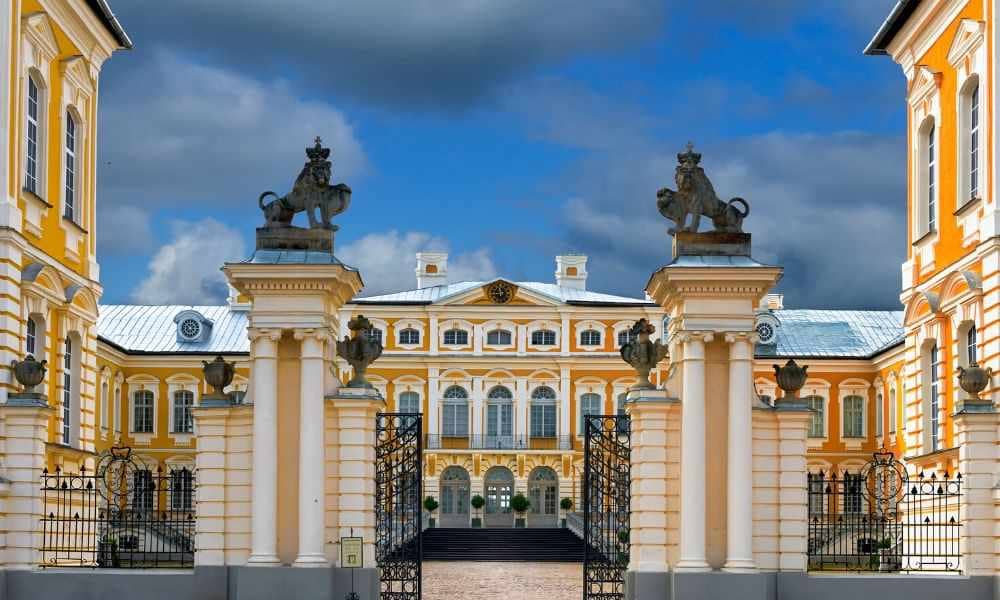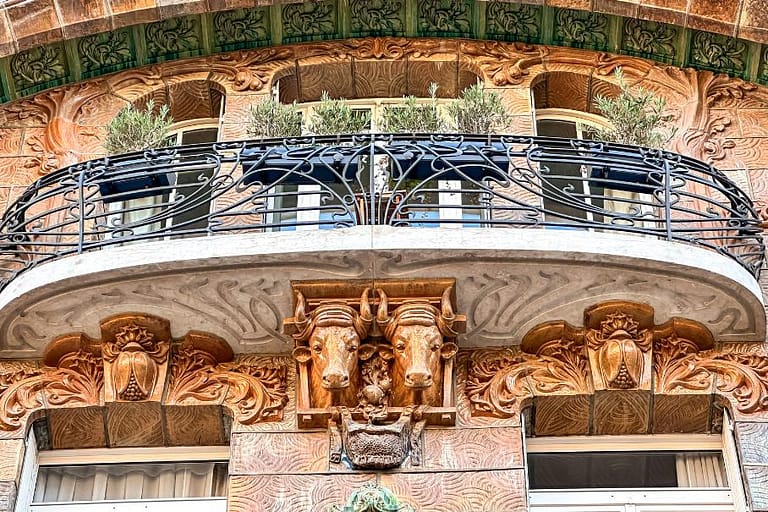Rundale Palace: Where History and Architecture Collide
PRESS TRIP – In the Latvian countryside sits an 18th-century Baroque-style architectural gem with magnificent French gardens. Rundale Palace (Rundales Pils in Latvian) has been dubbed the Versailles of Latvia, which should give you an idea of what you can expect to find here. If you love architecture or are looking for a one-of-a-kind adventure, Rundale Palace is a must-see destination in Latvia.
Built between 1736 and 1740 as the Duke of Courland’s summer residence, Rundale is one of Latvia’s grandest palaces. Its pale yellow facade creates a striking contrast against the vast plains surrounding it. I had an opportunity to explore the Palace when I was in Riga, and it totally charmed me. After all, I can’t pass up on a chance to explore a palace when I come across one.
Affiliate Disclosure – This post contains affiliate links. If you make a purchase through these links, I may earn a commission. This doesn’t affect your purchases or any fees you may pay for the product or service. Read more in my DISCLAIMER.
Arriving at Rundale Palace
As I stepped off the bus, I couldn’t help but imagine the countless visitors who must have arrived here over the centuries before me. While they may have been able to park their horse and carriages closer to the entrance, the excitement and anticipation were likely the same.
On this particular morning, a thick blanket of fog added to the mystery and allure of the palace. The magnificent structure emerged from the mist as we approached, surpassing all expectations. I had been anticipating a simple country manor, but instead, I came upon an enchanting palace that took my breath away.
While it might seem like a typical European palace, it is far from ordinary. Like many manors, castles and palaces, this one has a fascinating history and some controversial personalities that once lived here.


Rundale Palace fast facts:
- Built in the 18th century as the summer residence of the Duke of Courland.
- Designed by Italian architect Francesco Bartolomeo Rastrelli, who also designed the Winter Palace in St. Petersburg.
- 138 rooms, including several staterooms, private apartments, and a ballroom.
- A collection of original 18th-century furniture and art, including pieces by notable artists such as Louis-Michel van Loo and Johann Christoph Glaubitz.
- The gardens were designed by the French landscape architect Joachim Carvallo and span an area of 10 hectares (about 25 acres).
- Also functioned as a hospital, school and storage facility.
- The restoration took almost as long as its original construction, spanning over 43 years.

What was the Duchy of Courland?
The Duchy of Courland, also known as the Duchy of Courland and Semigallia, was established in 1561 following the dissolution of the German order of Livonian Knights. Gotthard Kettler, the last Master of the Livonian Order, became the first Duke of Courland. The nobility of the Duchy was formed by other members of the Livonian Order.
Over the years, the Duchy grew in power, gaining prosperity from shipbuilding and establishing territories in Africa and the West Indies. As it was fashionable during that time, contesting lands was somewhat of a sport among the royals of the day. For a time, Courland was a vassal state of the Polish king, then came under German and Prussian control before eventually falling under the rule of the Russian tsar.


In 1710, Anna Ivanovna, the niece of Tsar Peter the Great, married the Duke of Courland. After his death, shortly after their wedding, Anna ruled Courland by herself for about 20 years. Upon Peter’s death, Anna became the Empress of Russia. Here is where things get interesting.
The story of the Palace
In 1735, Ernst Johann von Biron, who was a favourite of Empress Anna and the newly appointed Duke of Courland, purchased this property with the intention of constructing his summer residence. A “favourite” referred to a person who was highly regarded by the king or queen and held a position of great influence. Although Anna played a part in Biron’s appointment, he was not well-liked by the local nobility, which ultimately led to his downfall.
After demolishing the existing medieval manor house, construction for the palace started. Designed by the Italian architect and official architect of the Russian court, Bartolomeo Rastrelli, the palace reflected the lavish tastes of the day. Recognizable for his Late Baroque style, Rastrelli also designed the Stroganov Palace and the Winter Palace in St Petersburg, as well as the Catherine Palace in Tsarskoye Selo. The intricate stucco, ceilings and wall stuccos were done by Johann Michael Graff, Carlo Zucchi and Francesco Martini.

Building construction at Rundale Palace slowed down when the focus shifted towards the Duke’s permanent residence at Jelgava Palace (historically known as Mitau Palace). It eventually came to a complete stop in 1740 due to the death of the Empress of Russia. Following her death, Biron, who was the Empress’s favourite, was arrested and exiled to Siberia. He narrowly escaped execution, which was a common fate for monarchs’ favourites in those days as they did not receive the same level of affection from their successors.
After his exile, Biron spent the next two decades away from Rundale Palace until his return was permitted by Catherine the Great. Upon his arrival in 1762, construction of the palace resumed and was completed in 1786. Biron spent a considerable amount of time at the palace until his death in 1772.
Rundale after Biron
Over the years, after Russia absorbed the Duchy of Courland, Rundale Palace was owned by several Russian nobles, including the Zubov and Shuvalov families. During Napoleon’s invasions, the palace was transformed into a hospital before being repurposed as a school. During World War I, the Germans converted the palace back into a hospital.


Unfortunately, the palace sustained serious damage during the 1919 Latvian War of Independence. The damage and neglect continued during the Soviet occupation after World War II. The once glorious rooms of the palace were even used to store grain at one point.
After years of neglect and damage, Rundale Palace was eventually restored to its former glory in the 1970s, thanks to the joint efforts of the Latvian government and the local community. It took extensive renovations costing over €8 million, but the palace finally opened its doors to the public in 2015, 43 years after the restoration project began.
Today, you can tour approximately 40 of the palace’s 138 rooms and stroll through the lavish gardens, exploring the opulent Baroque architecture and rich history of the palace while admiring the intricate interior. This is definitely a great spot for architecture lovers and history buffs. If you visit in the summer, the gardens will enchant you.
The comparison to Versailles is not unwarranted as Rundale Palace boasts magnificent French gardens and a surrounding forest, although on a smaller scale. With 16 buildings and approximately 210 acres (85 hectares) of land, the palace is definitely comparable. Looking at it today, it’s hard to imagine this stunning place used as a hospital, school or grain storage facility.

Visiting the Rundale Palace museum
Palaces and castles are some of my favourite museums. They allow us to see how people, albeit rich ones, used to live. Wealthy people had the means to hire talented artists, architects, builders and visionaries that created for them the spectacular gems we see today. They funded the arts and, by trying to outdo each other, left us places like this impressive palace to admire.
I love castles and palaces, grand manors and operas. While in Latvia, I jumped at the opportunity to tour Rundale Palace and, unsurprisingly, loved everything about it. From the fog-covered exterior to the richly decorated interior, I felt like a kid in a candy store. My excitement at being there was only topped because our tour guides were dressed in costume.





We were greeted at the bottom of a grand staircase by two grand ladies and a fashionable courtier, all dressed in their finest 18th-century attire. It appeared they were representing the duchess, who conveniently happened to be away. However, their playful approach to leading the tour and providing interesting insights into court life was anything but cheesy. The grand ladies even treated us to a dance performance that showcased the entertaining ways of the nobles at parties.
But that wasn’t the only fascinating thing we learned during the tour. Did you know that fans were also used as a secret way for ladies to communicate with their lovers? It’s true! Courtiers would use the way a fan was held or waved to send signals, and there were even guidebooks published on the subject. It was a discreet and clever way for ladies to express their feelings without being too obvious. It’s incredible to think that such small and seemingly innocent items could hold such a significant meaning and be used in such a sophisticated way in 18th-century courts.
Restoration efforts
The intricate detail and opulence of historic residences never cease to amaze me. Sure, with unlimited resources, the possibilities are endless. However, restoration efforts to bring back former glory are even more impressive, although they can take years due to limited funds and skilled craftsmen.
Despite the challenges, Rundale Palace underwent a major restoration, taking almost as long as it took to build the palace in the first place. If you counted the two decades of Biron’s exile when nothing was happening, it took 43 years in total. It would have been easier to count the losses and move on, but I’m glad they didn’t, or else there wouldn’t be Rundale Palace for me to explore today.

During our tour, we were shown a room that remained unrestored. It was an excellent way to see what the restorers had to work with and appreciate the contrast between the original and the restored. It gives you an appreciation of what they accomplished, and I think even Biron would approve.
Inside Rundale Palace
Rundale Palace is simply charming. As you stroll from one room to the other, you can imagine a world of a different time. Glamorous ladies and gents of the court strutted around in finery, gossiping and flirting behind their fans. Stately dinners and lavish balls in the painstakingly decorated rooms and over-the-top garden parties set on the walkways of the French gardens.



This is the perfect place for a fancy costume party that you definitely want to attend. I can’t imagine how that would go down, but I’m sure it would be epic. Let’s just say that in my head, this is totally happening.
Now, if you can’t make it to Rundale Palace any time soon, you’re in luck. There is a wonderful virtual tour that takes you inside the palace and outside of it. You can check out this link for yourself.


Getting here + admission
The Rundale Palace and gardens are open all year round.
Hours for the palace: 10 a.m. – 6 p.m.
Hours for French gardens: 10 a.m. – 7 p.m.
Admission: adult/child from €11/3.50
Pro tip: Can’t get there? You can explore Rundale Palace with a virtual tour!
Directions
From Riga through Bauska
Drive from Riga – 67 km along road A7 to Bauska, from Bauska to Pilsrundale – 12 km along with road P103.
From Riga through Jelgava
Drive from Riga – 47 km along road A8 to Jelgava, from Jelgava to Pilsrundale – 43 km along road A8 to Eleja and from Eleja by road P103 to Pilsrundale.
PUBLIC TRANSPORT: Bus traffic “Riga – Bauska”, then “Bauska – Rundale – Svitene”, “Bauska – Jelgava” (via Eleja or Jaunsvirlauka), “Bauska – Dobele” or “Bauska – Berstele”
Direction Riga – Bauska – Riga
Direction Bauska – Rundale – Bauska
Press trip info
Our excursion to Rundale Palace was part of the Women in Travel Summit (@witsriga) and was hosted by the Latvian Tourism Board (@enjoylatvia). The views and opinions are my own.
Travel Resources
Planning your next trip? Check out the resources I use and start planning your perfect getaway today!
- Flights: Find the best flight deals on Kiwi.com (my new go-to for flights)
- Book your accommodations: Find the best prices on hotels with Booking.com
- What to do: Find the perfect tour with Viator
- Need a car? Book your ride with Rentalcars.com
Check out my travel resource guide for more resources to help you plan your trip.









